#artificial taxonomy
Explore tagged Tumblr posts
Text

Just started collecting occlupanids a few weeks ago! My collection has quite a few color morphs of palpatophora glyphodorsalis, and specimens across 4 different families!
76 notes
·
View notes
Text

Bruno Moreschi, Recoding Art, short movie, HD, 14'50", 2019
0 notes
Text
Threats of Artificial Intelligence for Cybersecurity
Sfetcu, Nicolae (2024), Threats of Artificial Intelligence for Cybersecurity, IT & C, 3:3, ppp, Abstract Artificial intelligence enables automated decision-making and facilitates many aspects of daily life, bringing with it improvements in operations and numerous other benefits. However, AI systems face numerous cybersecurity threats, and AI itself needs to be secured, as cases of malicious…
#algorithmic biases#artificial intelligence#black boxes#cyber security#cyber-attacks#Cybersecurity#threat actors#threat modeling#threat taxonomy#threats
0 notes
Text
Okay, so we all know the real reason for the vampires-versus-werewolves thing in popular culture is because back in the 1930s, the same studio owned the movie rights to Dracula, Frankenstein and the Wolfman, and they decided to moosh them all together into what is arguably the first Big Stupid Cinematic Universe, but what's slightly less well known is that H G Wells' The Invisible Man was also part of that package. I want to see what the goofy we-swear-it's-personal-horror tabletop RPG based on that facet of the mythos looks like, weirdly artificial taxonomies of playable splats and all – everybody's invisible, but there are like five completely different possible reasons for that, plus a sixth, evil reason for being invisible which you're not allowed to play as because they secretly rule the world.
#gaming#tabletop roleplaying#tabletop rpgs#universal horror#universal monsters#vampires#werewolves#invisible men#media#movies#literature#tropes#history#media history#the invisible man#h g wells
4K notes
·
View notes
Text
I have been thinking about Tummy Bounce Taxonomy. Obviously the main branch is Tummy Bouncers, and then the next most closely related branch is Tummy-Scooters, including penguins, and then Tummy Sliders, such as otters and snakes.
Then on the other side of the taxonomic tree, the first group is Bouncers With Special Tummy Features, like kangaroos and wallabies. (Their branch might make a little loop around the stem, Jeremy-Bearimy style, to represent how they are mainly on the Bounce side of things, but there is also a Tummy aspect.)
And then a long horizontal line of Bouncers, where creatures like rabbits, antelope, and horses are arranged in order of how central Bouncing is to their means of locomotion. (eg, horses would be out at the far end since they only seldom Bounce.) This branch may split into some further categories, such as Jaunty Little Guys (incl. many small birds), but I have not figured that out yet.
#tummy bounce taxonomy#I am being silly#but also remember that all taxonomies are made up#Linnean taxonomy is older and probably more useful than tummy-bounce taxonomy#but it's not any more or less artificial
770 notes
·
View notes
Text
My general reading on the whole "materialism doesn't work for trans people because trans identity is an idea and biology is material" or however the fuck the argument goes is that the basic premise that certain biological characteristics can be assigned to either male or female categories is that "male" and "female" are themselves an artificial taxonomy - an idea - and ideas do not emerge independent of human thought. Ideas are very useful, and they are how we navigate our lives, how we understand ourselves and each other, right - like I'll make the potentially bold claim that your average person will process the information of the world around them in terms of ideas and presumptions, not strictly in the idea that there is a god but in terms of pure ideology - concepts of right and wrong, benign or dangerous, what is worthy of nuance and what is obvious and can be succinctly explained. That shit is all ideas, an interpretation of material reality. Gender in any sense is the same. Again, this isn't to discount anyones trans identity - but that cisgender presumptions are not more legitimate than trans identity, and any claims towards "material reality" to suggest otherwise are just the ravings of an idealist.
23 notes
·
View notes
Text
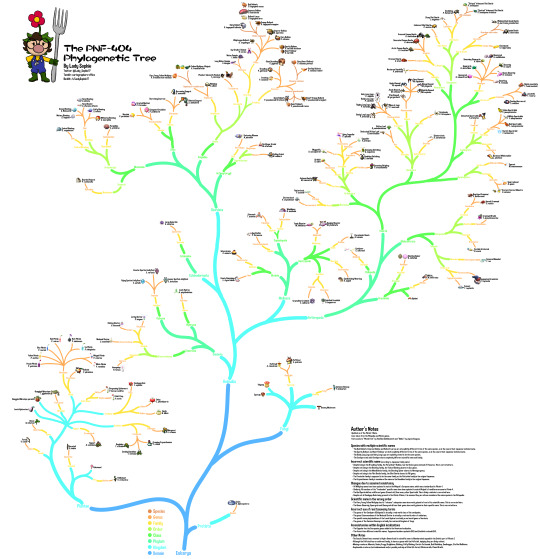
The PNF-404 Phylogenetic Tree
A bit of a different post from the usual, as I have been very hyped for Pikmin 4! Here's my speculative phylogenetic tree for most of the creatures in the Pikmin series. It is a bit more cautious than an actual phylogenetic tree, so there are a lot of soft polytomies (ideally every branch split should only have two children), but I digress.
Edit
It seems that Tumblr's compression did some nasty work on my post, so I'm gonna leave here a link to my phylogenetic tree in case anyone would like to see it in its full glory.
Here are also all the notes on the image in case anyone needs those too:
Author's Notes
Updated as of the Pikmin 4 Demo.
Icons taken from the Pikipedia and Pikmin games.
Fonts used are “Pikmin Font” by TheAdorableOshawott and “Dimbo” by Jayvee Enaguas.
Species with multiple scientific names
The Red Bulborb, Empress Bulblax and Bulborb Larvae are all explicitly different forms of the same species, as is the case in their Japanese technical name.
The Spotty Bulbear and Dwarf Bulbear are both explicitly different forms of the same species, as is the case in their Japanese technical name.
The Baldy Long Legs and Hairy Long Legs are explicitly stated to be the same species.
The Centipare and adult Centipare have completely different scientific name and family.
Incorrect scientific name (according to Japanese family name)
Despite being in the Breadbug family, the Fiery Dwarf Bulblax, has the Oculus genus instead of Pansarus. This is corrected here.
Despite not being in the Blowhog family, the Tusked Blowhog shares its Sus genus.
Despite not being in the Mandiblards family, the Shooting Spiner shares its Himeagea genus.
Despite not being in the Flint Beetle family, the Glint Beetle shares its Pilli genus.
The Floaterbie family is supposed to be the same family as the Flutterbie family in the original Japanese.
The Crysanthemum family is considered the same as the Dandelion family in the original Japanese.
Changes due to assumed consistency
All Wollyhop names have been updated to match the Wolpole's European name, which was standardized in Pikmin 4.
Similarly, All mentions of the “frodendum" specific name have been updated to match Wolpole's frondiferorum name in Pikmin 4.
The Red Spectralid has a different genus (Fenestrati) than every other Spectralid. This is likely a mistake is corrected here.
Despite not all Candypop Buds being present in the Pikmin 4 Demo, it is assumed they are all now considered the same species in the Piklopedia.
Scientific name in the wrong order
The Fiery Young Yellow Wollyhop has its “volcanus" subspecies name incorrectly placed in front of its scientific name. This is corrected here.
The Queen Shearwig, Speargrub and Sheargrub all have their genus incorrectly placed as their specific name. This is corrected here.
Incorrect use of real taxonomy terms
The genus Chilopoda of the Centipare is actually the real world class of the centipedes.
The genus Stauromedusae of the Medusal Slurker is actually a real world order of cnidarians.
The specific name phytohabitans of the Leech Hydroe is actually a real world genus of bacteria.
The genus of the Common Glowcap is actually the real world kingdom of fungi.
Inconsistencies within English localizations
The Coppeler has the Scarpanica genus added in the American localization.
The Armurk has different scientific names: Tegoparastacoidea reptantia (US) and Scalobita rotunda (EU).
Other Notes
The Caustic Dweevil was renamed to Hydro Dweevil and its scientific name to Mandarachnia aquadis in the Switch port of Pikmin 2.
Although the Puffstool has no confirmed family, it shares a genus with the Puffstalk, implying they are likely related.
Missing creatures: Mamuta, Smoky Progg, Blubbug, Puffy Blubbug, Electric Cottonade, Red Blubblimp, Seedbagger, Stuffed Bellbloom.
Unplaceable creatures (extradimensional and/or possibly entirely artificial life forms): Waterwraith, Plasm Wraith.
245 notes
·
View notes
Text
The Flowers of Buffoonery—narratological analysis
Note: Taking a trip down memory lane, I had an assignment in uni where we had to pick a topic and present it. Of course, my first choice was picking The Flower of Buffoonery (due to my rapidly increasing passion with Dazai's novels). And then I instantly regretted that choice 💀
But IGNORING the obnoxious amount of research I had to do on both literary theory concepts and also on Dazai's bio and biblio, I can wholeheartedly say it was fun! (in a masochistic way. Pls just end me; send help; I am done with this uni life).
So, without any further ado, I hope you'll enjoy this!
The aim of my project was to analyse the importance of the narrator and its impact on the reader while creating metatextuality. I focused on investigating how the narrator's role influences the reader’s experience, using Iser’s reader-response theory and Genette’s taxonomy of narrators. Iser’s insights into the interaction between text and reader illuminate how the narrative invites and challenges interpretation, while Genette’s typology highlights the narrator’s positional and functional dynamics.
This text seeks to establish how the reader’s imagination is being challenged intentionally by the aspect of a metafictional author, bestowing the reader with a significant role as an active agent in creating the meaning of the text. My findings revealed that the narrator oscillates between omniscient and intradiegetic roles, creating a layered metafictional experience that destabilises reader expectations and fosters active engagement. In a nutshell, Dazai’s narrative choices serve to emphasise the artificiality of storytelling, prompting readers to reflect on their role in "meaning-making."
჻჻჻჻჻჻჻჻჻჻჻჻჻჻჻჻჻჻჻჻჻჻჻჻჻჻჻჻჻჻჻჻჻჻჻჻჻჻჻჻჻჻჻჻჻჻჻჻჻჻჻჻჻჻჻჻჻჻჻჻჻჻჻჻჻჻჻჻჻
Before going further (hoping I didn't bore you with a sort of abstract), let me explain how those theories work.
Iser's reader-response theory emphasises the role of ambiguous "gaps" in fiction. I applied his concept of active reader participation to fill in narrative gaps, engaging the reader's imagination and analytical abilities. This interaction constitutes the core of metafiction's dynamic, with the reader's role being both rational and aesthetic. Simply explained, Iser focused on reception in literature and how the reader gives/creates meaning.
According to Genette, metalepsis is a narrative transgression where the boundaries between different levels of a story are blurred or violated. It happens when a narrator or character crosses from one narrative level to another, disrupting the usual separation between the world of the story and the act of narration itself. Theoretically speaking, these could happen in the following instances:
a. The character becomes aware of the narrator (or speaks directly to the reader)
b. The narrator does a lil self-insert in the fictional world
c. A narrator shifting unexpectedly between diegetic levels, such as influencing events in the story.
These are just some examples, but for our case, in The Flowers of Buffonery, we just have a simple case of a digressive narrator (I chose to interpret this novella as narrator ≠ author, since in my own view, narrator = a character in the story. This is purely my interpretation).
︵‿୨ APPLYING THE THEORY ୧‿︵
Now, with all these terms and theories explained, let's apply them.
Dazai employs a self-conscious narrator who directly addresses the reader, thereby disrupting traditional narrative boundaries. This technique is Iser's "implied reader" theory, where the text forecasts an active reader to fill in interpretive gaps. By engaging the reader in this manner, Dazai encourages a participatory reading experience, prompting readers to question narrative reliability.
Here are some quotes that could help you understand better what I explained:
This is on reliability:
"Time to face the facts. This pattern of inserting myself as the narrator between scenes, so that I can burden you with endless rants that no one needs to hear, has an ulterior motive. I’ve been exploiting my narrative position to hoodwink readers… So you see, I can’t be trusted. Don’t believe a single word I say."
This is on allowing the reader to construct meaning:
"Trust me, dear reader, if I were to present you with a real-life artist, you would puke before you made it through but three lines of description, guaranteed. If you don’t believe me, why not try writing a novelistic portrait of an artist for yourself?"
This is on engaging with the reader's perception:
"What’s that you say? Beautiful feelings make bad literature? Bullshit. Never have I heard so treacherous a phrase. Without transcendence, who could write a novel to completion? Every word and every sentence would assail the heart with a dozen possible meanings, until you had no choice but to snap your pen in half and toss it in the trash."
AND THIS is the collaborative meaning construction. Basically putting the weight on the reader's shoulders:
"You don’t need me. You can draw your own conclusions, things the author never could imagine. Then you’ll tell it from the mountain why this novel is a classic, crying out for all to hear."
჻჻჻჻჻჻჻჻჻჻჻჻჻჻჻჻჻჻჻჻჻჻჻჻჻჻჻჻჻჻჻჻჻჻჻჻჻჻჻჻჻჻჻჻჻჻჻჻჻჻჻჻჻჻჻჻჻჻჻჻჻჻჻჻჻჻჻჻჻
Now that I showed you how that reader-response theory works, let's move on to Genette's metalepsis. The narrative structure employed by Dazai is one where the boundaries between narrative levels are transgressed. All those self-referential comments from the narrator and direct engagement with the reader create a metafictional layer. These things make the reader question the nature of storytelling.
Another set of quotes✨
The narrator acknowledging his role and undermining the fictionality of the text:
"I wanted this novel to be an atmospheric romance. Starting with the churning maelstrom of the first few pages. My hope was to tease out and unravel all the different strands. As much as I might call attention to my clumsiness, I somehow got us this far — but now it’s all going to pieces." (reflection on storytelling choices, breaking the illusion of a self-contained narrative)
A key feature of metalepsis is making the reader question the credibility of the narrator:
"So you see, I can’t be trusted. Don’t believe a single word I say."
The narrator trying to influence our opinion on the text with this cute lil digression:
Surely by now, dear reader, you're disgusted with these young men for the carefree way in which they pass the time, as if one among them had not just killed another human being, though I suspect this new development will elicit shouts of joy.
჻჻჻჻჻჻჻჻჻჻჻჻჻჻჻჻჻჻჻჻჻჻჻჻჻჻჻჻჻჻჻჻჻჻჻჻჻჻჻჻჻჻჻჻჻჻჻჻჻჻჻჻჻჻჻჻჻჻჻჻჻჻჻჻჻჻჻჻჻
Dazai's novella exemplifies (in a stunning way, in my opinion) a layered narrative strategy, innovatively combining structural sophistication and reader interaction, contributing to the expansion of metafiction as a medium for both artistic expression and existential philosophical contemplation. Now, I can't know for sure if this was planned or just happened mid-writing, but he did great <3
჻჻჻჻჻჻჻჻჻჻჻჻჻჻჻჻჻჻჻჻჻჻჻჻჻჻჻჻჻჻჻჻჻჻჻჻჻჻჻჻჻჻჻჻჻჻჻჻჻჻჻჻჻჻჻჻჻჻჻჻჻჻჻჻჻჻჻჻჻
P.S.S. Yes, I will express my grievances and complain like a little bitch! The teacher didn't really appreciate my example. She ignored the theory and then jumped at me with, "Ohh, how do you know what the narrator really wanted to do? Did you ask him?" This hag pissed me off hard af.
P.S. What you read here is a watered-down version of my paper, written in a more accessible way for you (I spared you from all the bs ass in-text citations and the high academic style, at least as much as I could). I wanted to share my literary analysis mostly and shed more light on other Dazai books besides the big famous ones.
This was a STRICTLY LITERARY analysis, but I am sure I could maybe create an entire analysis on how much Dazai self-inserted himself in this book. Sadly, this could easily end up being a highly speculative point of view based entirely on fragments of biographical facts, so I may not do that. (Or I could try the good old Ouija board trick—). Just kidding.
#classic books#classic literature#quotes#osamu dazai#the flowers of buffoonery#flowers of buffoonery#literature#literary studies#literary analysis#book analysis#literary theory#wolfgang iser#gerard genette#university#uni#no longer human
15 notes
·
View notes
Text
the conversation around generative neural networks is a dumpster fire in a dozen different ways but I think the part that disproportionately frustrates me, like on an irrational pet peeve level, is that nobody in that conversation seems to understand automata theory
back before most of these deep learning techniques were a twinkle in a theorist's eye, back when computing was a lot less engineering and a lot more math, computer scientists had worked out the math of different "classes" of computer system and what kinds of problems they could and couldn't solve
these aren't arbitrary classifications like most taxonomy turns out to be. there's qualitative differences. you can draw hard lines: "it takes class X or above to run programs with Y trait", and "only class X programs or below are guaranteed to have Y trait". and all of those lines have been mathematically proven; if you ever found a counterexample, then we'd be in "math is a lot of bunk" territory and we'd have way bigger things to worry about
this has nothing to do with how fast/slow the computer system goes; it's about "what kinds of program can it run at all". so it includes emulation and such. you can emulate a lower system in a higher one, but not vice versa
at the top of this heap is turing machines, which includes most computers we'd bother to build. there's a lot of programs that it's been mathematically proven require at least a turing machine to run. and this class of programs includes a lot of things that humans can do, too
but with this power comes some inevitable restrictions. for example, if you feed a program to a turing machine, there's no way to guarantee that the program will finish; it might get stuck somewhere and loop forever. in fact there's some programs that you straight up can't predict whether they'll ever finish even if you're looking at the code yourself
these two are intrinsically linked. if your program solves a turing complete problem, it needs a turing machine; nothing less will do. and a turing machine is capable of running all such programs, given enough time.
ok. great. what does any of that jargon have to do with AI?
well... the important thing to know is that the machine learning models we're using right now can't loop forever. if they could loop forever they couldn't be trained. for any given input, they'll produce an output in finite time
which means... well, any program that requires a turing machine to run, or even requires a push-down automaton to run (a weaker type of computer system that can get into infinite loops but that you can at least check ahead of time if a program will get stuck or not), can't be emulated by these systems. they've got to be in the next category down: finite state machines at most - and thus unable to compute, or emulate computation of, programs that inhabit a higher tier
and there is a heck of a lot of stuff we conceptualize as "thinking" that doesn't fit in a finite state machine
...I suspect it will some day be possible for a computer program to be a person. I am absolutely certain that when that day comes, the computer program who's a person would require at least a turing machine to run them
what we have right now isn't that. what we have right now is eye spots on moths, bee orchids, mockingbirds. it might be "artificial intelligence", depending on your definition of "intelligence", but prompt it to do things that we've proven only a turing machine can do, and it will fall over
and the reason I consider this an "irrational pet peeve" and not something more severe? is because this information doesn't actually help solve policy questions! if this is a tool, then we still need to decide how we're going to allow such tools to be built, and used. it's not as simple as a blanket ban, and it's not as simple as letting the output of GNNs fully launder the input, because either of those "simple" solutions are rife for abuse
but I can't help but feel like the conversation is in part held back by specious "is a GNN a people" arguments on the one hand, and "can a GNN actually replace writers, or is it just fooling execs into thinking it can" arguments on the other, when the answer to both seems to me like it was solved 40 years ago
228 notes
·
View notes
Text

The Inland Sphynx (Homopantera terra) is a large sentient of the morphic genus Homopantera, native New Petra. It has a lean, broad-chested body; a proportioned humanoid head; round ears; and a dark, hairy tuft at the tip of its tail. It is not sexually dimorphic. The Inland Sphynx lives alone, but socialises.
Etymology The word 'Sphynx' is a Greek corruption of the Egyptian name 'shesepankh', which meant 'living image'.
Taxonomy Homopantera terra is the current designation in use in New Petra. Other species are Homopantera maritimum (Coastal Sphynx), Homopantera androphagon (Manticore) and Homopantera ornata (Lamasu). Some have proposed the alternative name: Homopantera civitas instead of terra.
Description The Inland Sphynx is a lean, broad-chested like-felid with a humanoid head, a reduced neck, and round furred ears. The base of the tail and the area behind the forelimbs are densely feathered.
The fur varies in colour from light buff to silvery grey, yellowish red, and dark brown. The colours of the underparts are generally lighter. Both male and female Inland Sphynx retain spots into adulthood. Feather colours are generally bright, with purples, reds, oranges and metallics being common. Hair ranges from any natural human colour, though is frequently dyed to match the feathers. The tail of all Inland Sphynx ends in a dark, hairy tuft that conceals a hard 'spur' that is formed from the final, fused sections of tail bone.
Its skull is very similar to that of a standard human, though much larger. Faces are frequently oval with pronounced, elevated, and arched eyebrows, large almond-shaped eyes, well-defined cheeks, full lips and a prominent, pointed chin. Males frequently cultivate a beard. Canines are only slightly more developed than a human's, and dentition supports omnivorous eating.
Large paws have fully retractable claws and are notably agile compared to other Homopantera, enabling limited tool use and more elaborate grooming. Instead of a dew claw, they have a thumb, though the size of their digits limits precise actions.
The average Inland Sphynx is approximately 170cm long with a tail length of 80 cm, and a weight of 120 kilos. Females are only slightly smaller than males.
Distribution and habitat The Inland Sphynx is found only in New Petra and does not travel. As of this writing, around fifty individuals are registered with the Bureau of Population.
Behaviour and ecology Inland Sphynx spend much of their time resting; they are inactive for about sixteen hours per day. Although they can be active at any time, their activity generally peaks after noon with a period of socialising, grooming, and then activity in their chosen profession.
While they are solitary amongst their own species they commonly live close by other sentients and have reciprocal arrangements for grooming, entertainment, and health related reasons.
The Inland Sphynx is a generalist omnivore and prefers cooked food. It is a poor hunter unless trained to do so, as it's needs are generally met through the society that it functions in. When it is required to fend for itself, it generally hunts by ambush from a raised platform or tree - it cannot fly, but is capable of fully extending the feathers around it's forelimbs to allow a controlled fall. They prefer small game, rich fruits, and enjoy wine and other fermented substances.
Reproduction is limited and sporadic, resulting in a large egg that requires brooding for 110 days. Inland Sphynx who want to have offspring have access to artificial incubators in New Petra. Cubs are somewhat altricial, despite being born with fur, and must be parented for four years before reaching adult size. They make decent parents despite being generally solitary, cubs receive schooling along side other youth in New Petra.
Morphic ecology notes
All Homopantera are capable of shifting species according to adaptive pressure. The Inland Sphynx is particularly prone to shifting to a Coastal Sphynx body and lifestyle should they engage in any of the following behaviours:
Eating sentients
Engaging in blood sports
Spending time with Coastal Sphynx
Ceasing intellectual pursuits
Engaging in anti-social behaviour
Inland Sphynx can rarely shift to a Lamasu under the following situations:
Eating predators
Developing a martial outlook
Developing an obsession with astronomy and philosophy
Behaving in an ascetic manner
Adhering to a strict set of behavioural rules
Inland Sphynx cannot become Manticores unless they go through a Coastal Sphynx transformation first.
Social notes
Inland Sphynx ornament and decorate themselves when they have the assistance of humans to do so. They maintain themselves neatly, and are frequently in the University District. Those who cannot maintain academic pursuits have the physical strength to do more mundane jobs such as dock workers or pull carts. They generally avoid roles such as scouts or guards to avoid morphic shifting.
Generally occupations chosen by Inland Sphynx include various academic focuses, due to their excellent memory. They favour writing, mathematics, history and stories. They all admire riddles, and can develop obsessive behaviours around them.
Most Inland Sphynx speak several languages, and are gregarious as long as they can return to their own home, alone, and recharge in peace.
22 notes
·
View notes
Text
Alagaësia Lore And Headcanons Series, Part 2: Human Languages of the Broddring Empire
Given that by the time the books take place, there is really only one human language, most of this post is going to be on the Headcanon side of "Lore and Headcanons". Still, my observations will be based in canon, drawing from place names as well as given names of characters. Where I run out of canon to draw from, I will be taking a lot of inspiration from the history of real-world languages, but not so much as to eliminate the uniqueness of the setting. Or at least I will try.
-Lights
Taxonomy
Human languages of Alagaësia can be roughly split into four distinct families: Broddring, Surdan, Petrovyan and Hadaraki. Of these, the former three show similarities in their grammatical structure (being overwhelmingly synthetic, but non-pro-drop languages) which may indicate that they split away from their ancestor language - a theorized "proto-mannish" - later than Hadaraki, which seems as far removed from them as it is from the Ancient Language. As this post is dedicated to languages of the Broddring Empire, Hadaraki, i.e. the languages of the Wandering Tribes (which never submitted to Broddring authority) will be given their separate post.
The Broddring Language Family
By this term, we understand any and all languages that evolved from the language spoken by the tribe of King Palancar at the time of their arrival in Alagaësia. The name "Broddring" comes from the singular form of the name of Palancar's tribe - Broddringas. Interestingly enough, it seems to be an exonym bestowed by a closely related tribe, translating roughly to "Brother's kin" (from brodor and the kinship suffix -ing).
Archaic Broddring This was the language spoken by Palancar upon his arrival in Alagaësia. While it had already developed the typical grammatical features of the later Broddring languages, its vocabulary was so far removed from theirs as to be completely incomprehensible to a speaker of present-day Broddring. This is due to the fact that after coming into contact with the Elves, Archaic Broddring started adopting (and modifying) words from the Ancient Language en-masse, which would eventually lead to the two languages sharing up to 40% of their vocabulary. The resulting amalgam would become known as...
Old Broddring Language of the early Broddring kings who resided in Ilirea. It had a rich inflection system, with four cases (nominative, genitive, dative and accusative) and three numbers (singular, dual and plural). Despite being different enough from the Ancient Language as to lack its truthsaying and magical properties, it was similar to the point of mutual intelligibility:
OB: Andumë ond Fíronmas on thaem sorga hyll, lichama sin glaese gelic.
AL: Andumë un Fíronmas äthr dem harmra hyll, leikrar theirra glaere gelikr.
(similarities illustrated on the sentence "Andumë and Fíronmas at the hill of sorrows and their flesh like glass." spoken by Glaedr in Inheritance.) Given that not only vocabulary, but also parts of grammar seem to have been adopted by the Broddringas, discussions abound among scholars as to whether Old Broddring is Archaic Broddring in an Ancient Language cloak, or the Ancient Language in a Broddring cloak. It was this language that gave rise to the Toskan dialect, an artificial dialect created by Tosk for the purposes of the Religion of Helgrind.
Present-day Broddring Just as Old Broddring is the result of a metaphorical melting pot of Archaic Broddring and the Ancient Language, present-day Broddring is the result of Old Broddring interacting with the rest of the human languages of Alagaësia during the Broddrings' conquest. Again, it borrowed massively, mainly from Aberonian and Old Surdan (more on those below). This was not the case of the conquerors borrowing vocabulary from the conquered, but rather the conquered attempting to speak the conquerors' language and substituting the words they did not know with ones from their own languages. Moreover, as Broddring gradually became the lingua franca of a multi-national kingdom, the number of non-native speakers outgrew that of the native ones. This led to a significant simplification and streamlining of grammar. The number of lexically realized cases was reduced drastically until only two - the subject case and the object case - remained. As a result, the word order became much less flexible and Broddring as a whole became more analytical rather than synthetic. Numbers were reduced to only singular and plural.
The Lost Languages of Surda
By the time of the Fall of the Riders, only the Broddring lanuguage was spoken in Surda. Indeed, the ruling dynasty started by Marelda of Langfeld and continued by the Queen Frida and the Kings Larkin and Orrin was ethnically Broddring. Still, some of the languages of the tribes that first settled Surda and remained there even after Palancar and the Broddrings left for the north survive in toponyms, given names, folklore and old documents.
Aberonian Aberonian seems to be the language most closely related to the unattested proto-surdan language spoken by the first settlers. It survives only in its formal, literary form, preserved by the Arcaena sect (the name of which itself derives from the aberonian word for "secret"). Both its name and that of the current capital of Surda comes from the tribe called Aberati. We can only speculate as to the meaning, but it may be related to the verb aberro, "to wander away". Aberati could therefore be taken to mean "Wanderers", "Explorers" or potentially "Exiles". Many traditional surdan given names have aberonian origin, like that of King Orrin, which derives either from the word orans ("he who prays", i.e. pious) or orum ("gold, golden"). It carries an air of tradition and authority in the surdan public consciousness and prior to Surda becoming a province of the Broddring Empire, her monarchs would swear oaths of office in both Aberonian and the Ancient Language. This tradition would be later revived by Queen Frida, daughter of Lady Marelda and the first Langfeld monarch.
Old Surdan The contemporary of Old Broddring and the source of many of the borrowings that transformed Old Broddring into its present-day form. If little survives of Aberonian, then what we have left of Old Surdan may well be nothing. It originated as a spoken dialect of Aberonian and continued to evolve even as Aberonian fossilised in its literary standard. It would eventually overtake it as the official language of Surda, as it was more familiar to the common folk and was not as strictly policed by scholars and nobles. Today, it only survives in the form of folk songs, nursery rhymes and old government records. Those capable of reading and translating it are few but highly sought after by the Surdan government.
Petrovyan Very little is known of the Petrovyan language, as even the term is most likely not what the speakers themselves called it, only that it does not seem to be closely related to either Broddring or Surdan and Aberonian. It was spoken by a human tribe that landed in Surda but migrated north (possibly as far as Gil'ead), before being pushed back to the site of today's city of Petrovya by the Broddring expansion. By the time of the Rider War, only fragments remain in dialectal expressions, toponyms (like Petrovya itself) given and family names (like that of Marcus Tábor) and local swearwords.
Real World Inspirations
The evolution of the Broddring language was heavily inspired by the real life history of English. The Ancient Language in this analogy is Old Norse, which influenced Old English to such a degree that Middle English is disputed by some scholars to be a scandinavian language (see English: Language of the Vikings by Joseph Embley Emonds and Jan Terje Faarlund). The Surdan language family is based on Romance languages, with Aberonian roughly corresponding to Classical Latin and Old Surdan to the Vulgar Latin-Old French continuum. Petrovyan was inspired by Slavic languages because, well, the name.
#eragon#inheritance cycle#alagaesia lore series#eragon headcanons#christopher paolini#humans#broddring#surda
18 notes
·
View notes
Text
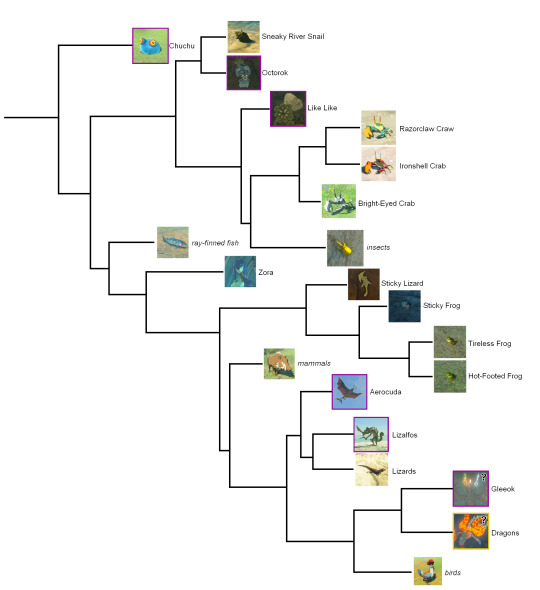
Taxonomy for animals in hyrule (or things that would be considered animals).
For the general chart:
I didn't always include all the variations of an animal.
Only naturally occurring, biological things are included. Nothing that was artificially constructed.
Some minor spirits are included, but only a few. For most of the spirits I don't think they would follow the laws of biology.
I think chuchus are a very primitive form of animal. Possibly a cnidarian or a closely related group?
Likelikes are type of worm.
I know that the sticky lizards literally have lizard in the name but I will always see them as a sort of salamander.
I'm not sure if gleeoks should even count as tetropods. I'm also not sure if the dragons should even be considered naturally occurring. However, if I were to assign them a place I would put them in a group that is alongside, but separate from, dinosaurs and crocodilians . The leviathans might also fall into this group.
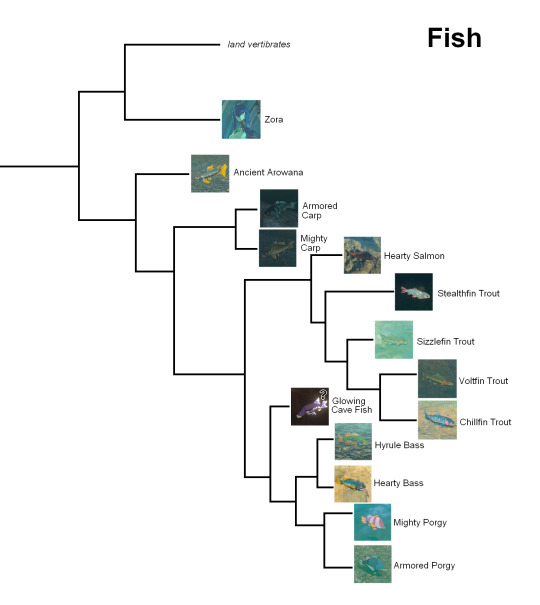
For fish:
I'm not sure about the glowing cave fish, since they don't say what type of fish it is and I know basically nothing about fish taxonomy. I've put it in percomorpha since it's the largest group of fish.
Since the zora can breath water and air I assume they're related to lung fish.
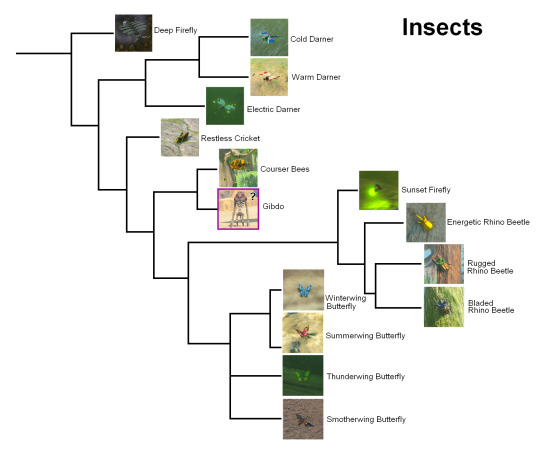
For insects:
I've seen several headcanons about what the gibdo are. In this case I'm interpreting them either as a humanoid insect or as a insect that controls corpses.
I don't think deep fireflies are fireflies at all. I think they are distantly related to all other insects.
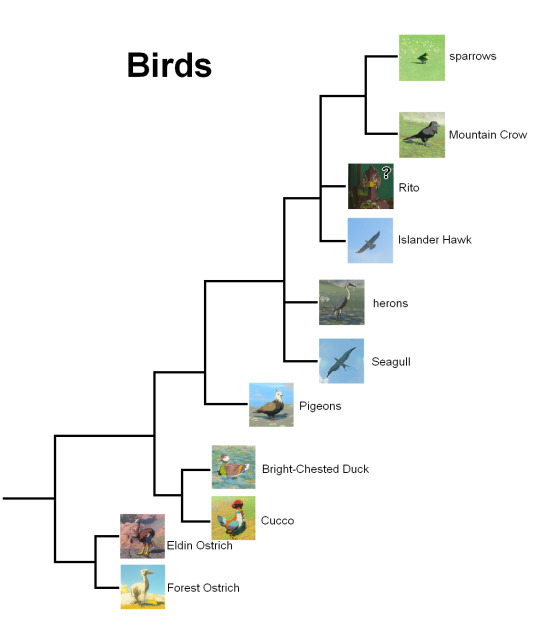
For birds:
I didn't include the many varieties of sparrows and pigeons. I also didn't include the two types of heron and two types of seagull. There is no much to say about them other than the fact that they're very closely related species or sub-species.
I don't think the rito are related to the rito from wind waker. Instead, I think that the term 'rito' is used for any bird-like humanoid in the Zelda universe. I'm not too certain about how to classify the rito. In fact, I think it might be possible that there are several unrelated species that are all called the rito.
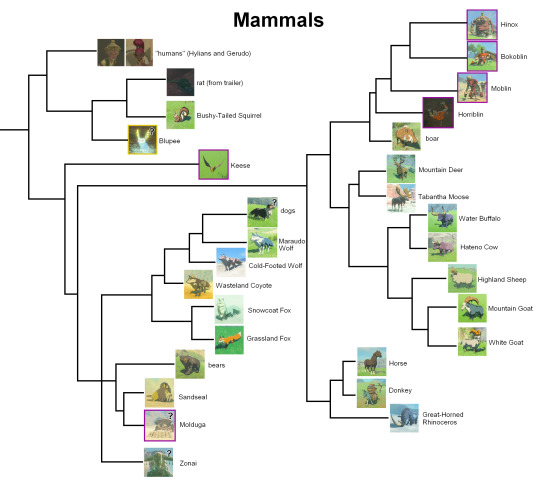
For mammals:
There are a few animals whose existence is implied but never shown: these are monkeys, elephants, and camels.
Blupees are on here because they're described as rabbit like, but I personally would consider them more spirit than animal.
I put here that dogs came from Maraudo wolves, but it might be possible that dogs were domesticated from a different species of wolf found outside of Hyrule.
I'm not really sure about moldugas. I put that they're related to sand seals, but I can't be very sure. I don't even know if moldugas are mammals.
I know that the internet has apparently decided that the zonai are goat-adjacent, but I never saw it that way. I refuse to say they're an ungulate when they don't even have anything resembling hooves. For now I have tentatively put them in carnivora.
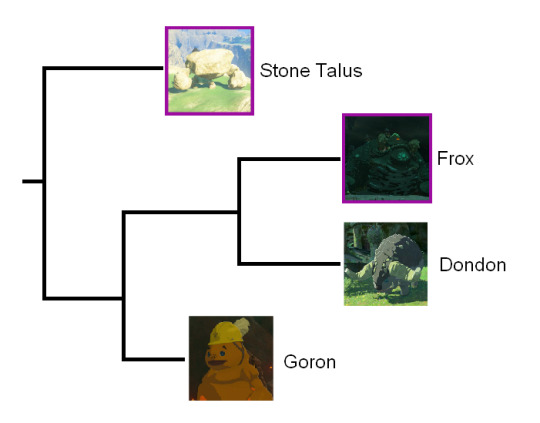
For rock creatures:
I think all the 'rock based creatures' form a biosphere that is completely unrelated to the normal biosphere. This would mean that hyrule has no universal common ancestor. Life arose independently at least twice.
I know that the dondons appear in the middle of the 'mammal section' of the compendium, but I am ignoring it.
Other stuff:
I didn't include lynels because I have no idea what's going on with them. They're definitely mammals (but again, technically a hexapod). But I have no idea how to classify them further.
I also didn't include wizzrobes because I have absolutely no idea what's going on with them.
55 notes
·
View notes
Text
There are multiple pathways from Anne Carson’s poetry to Ross Gay’s prose. One need only listen, the Poetry Center at the University of Arizona in Tucson reminds us, and follow the trail of audience participation, decolonization, and ants.
In August 2024 the center announced the complete transcription of Voca, the audiovisual archive of its poetry recordings, including its longtime reading and lecture series, which began in 1962. The result is more than twelve thousand captioned media files of poets reading—and talking about—their poetry, making the archive’s intellectual content accessible to users with disabilities, visible to search engines, and available for linguistic computational analyses, library director Sarah Kortemeier says. The transcriptions date back to the center’s earliest recordings, in 1963, and amount to some six million words, spoken in at least twenty-five languages, including Japanese, classical and modern Greek, Bosnian, Swedish, Arabic, Diné Bizaad, and O’odham. A reading by Ada Limón held in 2024. (Credit: Tyler Meier)
This enormous undertaking was made possible by a 2021 Mellon Foundation Public Knowledge grant of $135,000, which allowed Voca to hire professional transcribers to create the initial text documents. (Artificial intelligence was only of limited help in creating transcriptions, Kortemeier found: Large language models “are trained to predict the most likely word in a sequence based on thousands of other texts,” she says. “But when we write poems, we’re frequently looking for the most surprising next word, not the most likely one!”) Over three years, the center’s library staff and graduate student interns proofread, revised, and uploaded the transcriptions—with input from the center’s staff and community on some non-English language entries. The center also collaborated with web developers at the University of Arizona’s College of Humanities to redesign the Voca site to enable captions, as well as new features like playlists and lesson plans.
A unique aspect of the archive is that it captures poets talking extemporaneously about their work. This spontaneous reflection is another reason the universal design of captioning is so important, Kortemeier says. “An author’s commentary can provide a crucial on-ramp for access to the poem, an open invitation to experience the artwork with the artist.”
While Voca’s digital cataloging system already flagged recordings of early drafts, captioning helped identify “real wild cards—poems that subsequently got chopped up into multiple published pieces, say, or poems that retained only a couple of lines from the first draft in their final published versions.”
A reader might begin exploring Voca with a 2001 reading by Anne Carson, in which the poet coaches her audience through an interactive performance of several of her “short talks.” Carson’s words light up on-screen as she promises their first assignment is easy; at her signal, all they have to do is call out a single word, deciduous, in a questioning tone. “Okay,” she warns them with mock sternness, “remember your line.” (They nail it.)
Entries in the Voca archive are accompanied by keyword tags generated by library staff (and, in some older examples, by members of the public), creating a site-wide taxonomy of literary ideas. Carson’s reading is tagged: classics, audience participation, franz kafka, john keats, beauty, innovative, painter, artists. Clicking on “audience participation” offers a spate of other recordings, including a 2014 reading by Craig Santos Perez. Introducing the event, Poetry Center executive director Tyler Meier thanks the audience for braving local storms. Then Perez himself explains that the weather has cost him one of the props for his series of poems on colonization and American food: When the center warned him his flight might be canceled, he ate his can of corned beef. One doesn’t need the audio to know there is laughter in the room.
Clicking on decolonization, one of Perez’s keywords, will send a reader to Sawako Nakayasu discussing source texts for her “micro-translations,” including Adam Pendleton’s “Black Dada” and Ron Silliman’s “Ketjak.” Such references are easily missed in a live event or audio recording; the transcripts, which have been uploaded as plain-text files, can be scrolled through or searched to verify a word. The text format also offers a treasure trove of material for digital humanities scholars. Kortemeier hopes for the creation of a Voca concordance (an alphabetized index of key terms and their usage), which would allow for the study of the frequency with which poets use certain words across the archive’s six decades—just one avenue of research made possible by Voca’s transcription.
Nakayasu’s irresistible keyword ants delivers a Voca visitor to Ross Gay, reading poems from his insect-friendly Catalog of Unabashed Gratitude (2015) as well as “essayettes” from a work-in-progress.
Gay’s reading, on the eve of Donald Trump’s first presidential inauguration, is accompanied by a Q&A in which the poet describes the inspiration he finds in human interactions. Walking to an Ethiopian restaurant earlier that day, Gay recalls, he saw a man in roller skates—“half purple and half pink”—skating over something written on the sidewalk: Repent. Fear God. The skater, Gay delightedly observed, was slowly erasing the text as he rolled across it. “That person,” Gay promises, “is going to show up in something I write.”
Two years later, he did. The pink-and-purple skater and the message over which he rolls appear in The Book of Delights (Algonquin Books, 2019), the book those budding essayettes would become. The Voca transcript makes it simple to compare the two texts—Gay’s off-the-cuff story and its eventual manifestation in print—side by side. In the published version, the pink of the skates is refined (“a color I want to call fuchsia but I think that’s wrong. Magenta?”) and the pavement text is now “REPENT OR BURN,” but the anecdote is largely unchanged. Then the essayette swerves, in its final line, into new territory. As he watches the skater erode the text, the poet recognizes himself as part of the tableau—and active in it. “And, too,” Gay concludes, “the slight erosion was I, admiring him steadfast like this, all the herons in my chest whacking unrepentantly into the sky.”
Reading along exemplifies what’s precious about Voca’s transcription project: In following the text’s development, in listening to writers discuss their own work and discovering their lines of intersection—from Carson to Perez to Nakayasu to Gay—more readers can chart a poet’s imagination taking flight.
Evangeline Riddiford Graham is the senior editor of Public Seminar and host of the poetry podcast Multi-Verse.
#poets and writers magazine#poetry#poems#poets#archive#digital archiving#digital archive#digital archives#archives#20th century#history#linguistics#language#technology#sound#recording
2 notes
·
View notes
Text
Zoomposium with Professor Dr. Achim Stephan: "I feel, therefore I am. How feelings influence our thinking."

In another very exciting interview from our Zoomposium themed blog "Epistemology and Philosophy of Mind", Axel and I speak this time with the well-known German philosopher Achim Stephan. He "studied philosophy, mathematics, education, psychotherapy and psychosomatics at the Universities of Mannheim and Göttingen and is now Professor of Philosophy of Cognition at the University of Osnabrück. Since 2003, he has also been Dean of Studies for the Cognitive Science course. His main field of work is the philosophy of mind, particularly emergence, emotions and affectivity." (https://de.wikipedia.org/wiki/Achim_Stephan, emphasis added)
I had been aware of Mr. Stephan for some time, as his name was frequently mentioned in connection with #emotion research and the concept of #emergence during my research for my essay "The system needs new structures - not only for/against artificial intelligence (AI)" (https://philosophies.de/index.php/2021/08/14/das-system-braucht-neue-strukturen/). This was specifically about the question of the extent to which the concept of "embodied or situated cognition" or enactivism could play a role in the constitution of "artificial consciousness". In his articles "Embodied Targets, or the Origins of Mind-Tools" (2006) or "A Taxonomy of Environmentally Scaffolded Affectivity" (2021), for example, he dealt very intensively with the question of how embodied or situated cognition influences our thinking or even makes it possible in the first place.
As his research also focuses on the phenomenon of "emergence", which he examined in more detail in his book "Emergence: From Unpredictability to Self-Organization" (4th edition 2016) and his articles such as "Phenomenal Emergence" (2004) and "Consciousness: Emergent and Real" (2015), it was naturally all the more tempting to ask him about the possibility of "artificial consciousness". He had already explicitly explored the possibilities of emergent properties, forms of communication and affects in artificial agents in other articles, such as "Emergent Properties of Natural and Artificial Systems" (1998), "Communication and cooperation in living beings and artificial agents" (2008) and "Could positive affect help engineer robot control systems?" (2011).
Of course, this interview was not only about "artificial intelligence", but also about "natural intelligence" in particular. As Professor Stephan is also a proven expert in the field of education, psychotherapy and psychosomatics due to his many years of learning and research activities, we naturally also asked him about this topic.
More at: https://philosophies.de/index.php/2024/04/23/ich-fuehle-also-bin-ich/ or: https://youtu.be/gMherlB50K4
#feelings#thinking#emergence#artificial consciousness#artificial intelligence#ai#philosophy#neuroscience#embodiment
4 notes
·
View notes
Text
Okay so I actually have so many questions about the pokemon world but none of them are, like, good worldbuilding questions. This isn't a post about meaningful questions with any bearing on the story or characters whatever. This post is 'okay so taxonomically, are pokemon animals?' because I'm just. so curious about the implications of this. I'm fascinated by this. All pokemon would at LEAST be eukaryotes, right? They have to be, if they reproduce through eggs. But what about artificial pokemon? Are they technically not animals? Are phylogenetic trees just an entirely different type of weird in the pokemon universe to account for this? Is there less of a meaningful distinction between cellular and non-cellular materials because of whatever, like, rock pokemon have going on? Do their phylogenetic trees just not break things down into 'prokaryotes' and 'eukaryotes'? Separate note more about specific taxonomy stuff, what about the overlap of plant and animal pokemon? Tropius produces fruits, making it an angiosperm, but is it an animal in addition to a plant (both at once)? Is the plant separate, is it an animal AND a plant separately? It photosynthesizes but it also presumably needs food from external sources as well, right? Literally what even is Rotom. It's plasma. What are the implications of it being alive. Deoxys needs its own three-part post. I'm not smart enough for any of this but I want to stare at a wall and think about it for three hours. ARE THERE POKEMON MICROBES. Don't even get me started on the vetmed side of pokemon science. I'm probably going to get myself started on it later when I have less to do.
5 notes
·
View notes
Text
2023 Reading Log pt 12

56. Life Between the Tides by Adam Nicholson. This book really, really wants to be High Literary Art. The author writes about tide pools and coastal organisms, but is much more interested in dissecting what these have represented in art, culture and a Jungian sense of shared humanity more than he is in the actual animals, algae and other things he encounters. Throughout the book, he builds three artificial tide pools, each time devising ways to carve rock and set up filters to catch water but exclude some organisms, and I couldn’t help but think, why? Why not find natural tide pools and observe them? Why must you put your stamp on a coastline? His whole thesis seems to be something about the beauty of how the shore is a liminal place, between land and water, where ecosystems and humans alike exist in an unstable equilibrium, and yet he feels the need to attempt to control it, and does not reflect much on the contradiction. I did not care for this book, as either a work of natural history or philosophy.

57. Spirit Beings in European Folklore 1 by Benjamin Adamah. A birthday gift from my girlfriend, @abominationimperatrix. This is one of a four part encyclopedia of European monsters—this volume focuses on Scandinavia and the British Islands. The decision to edit it into multiple volumes was made relatively late in the book’s development, and it shows—there are cross references to entries that do not appear in this book, but are in other volumes. The author is an occultist, and so plays somewhat coy with whether or not he believes in the literal existence of supernatural entities; near as I can tell from this volume, he’s a believer in the idea that they have material reality as thoughtforms created by human imagination. Putting aside that quirk (which is fairly easy to do), this is a pretty good compendium of monsters, especially but not limited to the sorts of things that would be called “fey” and “undead” in RPG terms. I do have the whole set, and am looking forward to reading the rest of them.
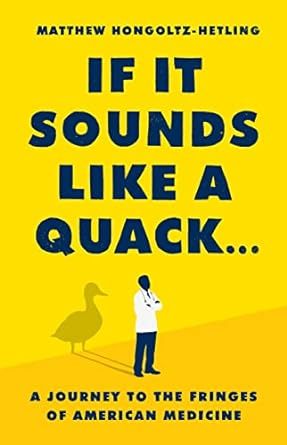
58. If It Sounds Like a Quack… by Matthew Hongolz-Hetling. This book is a look into “alternative medicine” grifts and cranks, following the stories of six quacks from their origins to the modern day. This modern day is the COVID era, where even the most reasonable-sounding of them goes off the deep end into conspiracy theories and anti-immigrant hysteria. The author does an excellent job of using alternative medicine as a lens to look at how consensus reality has been damaged in the United States, and there are a surprising amount of connections, both direct and indirect, between these frauds and perhaps the most successful con artist of the modern era, Donald Trump (who the book refers to exclusively as “the game show host”). The book has a light touch and is very funny throughout, which makes the ending, where he discusses how people are committing real murders in the belief that COVID vaccines are turning people into zombies, hit all the harder.
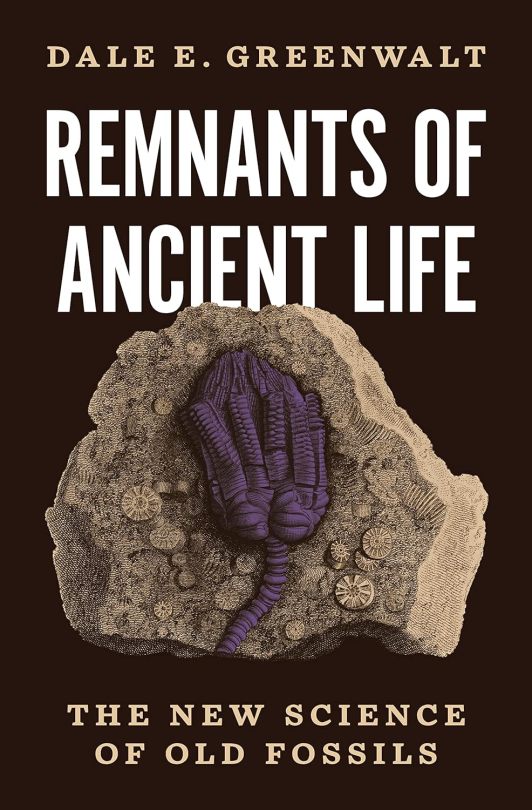
59. Remnants of Ancient Life by Dale E. Greenwalt. This is a book about biomolecules found in fossils, from the famous (like pigments found in dinosaur feathers) to the rather more obscure (using trace elements to pinpoint the affinities of conodonts and Tullimonstrum). The author is an entomologist by trade, and so is a little bit unclear about the appropriate taxonomy for other groups—an editing pass over the chapters about dinosaurs would have been useful. Perhaps the most interesting chapter is on the supposed discovery of dinosaur proteins, such as collagen and even intact blood vessels, which have been almost entirely done by the lab of Mary Schwietzer, and thus are the subject of a lot of debate and skepticism.

60. Strange Bedfellows by Ina Park. This is a book about sexually transmitted infections. It can be divided roughly in half—the first half is chapter long looks at particular topics, like the stigmatization of herpes and the possible health risks of vigorous pubic hair removal. The second half is a historical survey of the history of government investigation of sexual health, including both unethical human experiments such as at Tuskegee and Guatemala, as well as the history of contract tracing in public health offices. The author’s voice comes through strongly—she’s funny and opinionated and not at all ashamed at working in a sex related field. Mary Roach wrote one of the blurbs on the back of the book, and that seems like a pretty apt comparison.
#reading log#medicine#sexually transmitted infections#quackery#alternative medicine#paleontology#folklore#monster book#marine biology
11 notes
·
View notes